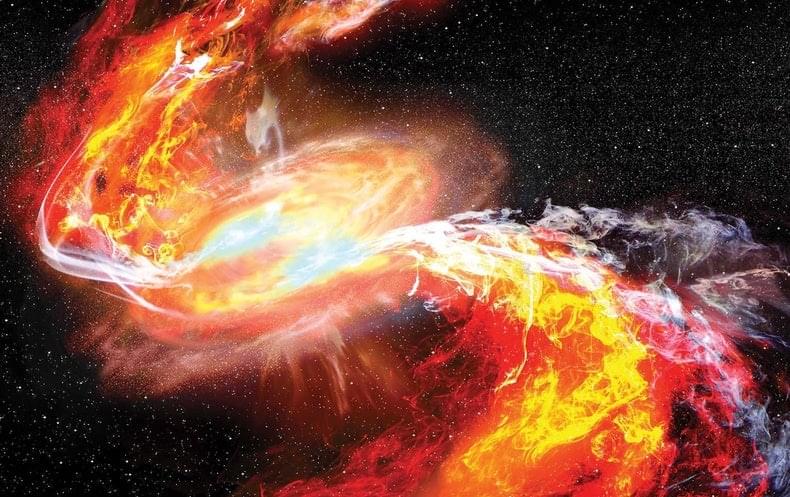Feb 25, 2023
Dark skies: Venus, Jupiter and the Moon pictured across Wales
Posted by Dan Breeden in category: space
Stargazers across Wales were able to witness Venus, Jupiter and the Moon aligned in the night sky on Thursday.
Stargazers across Wales were able to witness Venus, Jupiter and the Moon aligned in the night sky on Thursday.
The James Webb Space Telescope found six massive galaxies that some scientists never thought could exist. The telescope is so powerful it might have just shattered scientific understanding of the universe. Theoretical Physicist and best selling author Dr. Michio Kaku talked to Gadi Schwartz about the groundbreaking report.
NASA announced Wednesday it has issued an award to The Boeing Company for the agency’s Sustainable Flight Demonstrator project, which seeks to inform a potential new generation of green single-aisle airliners.
Under a Funded Space Act Agreement, Boeing will work with NASA to build, test, and fly a full-scale demonstrator aircraft and validate technologies aimed at lowering emissions.
Over seven years, NASA will invest $425 million, while the company and its partners will contribute the remainder of the agreement funding, estimated at about $725 million. As part of the agreement, the agency also will contribute technical expertise and facilities.
A chunk from the fireball meteor that exploded on Feb. 15 has been recovered. Other fragments of the hefty space rock were likely showered across the nearby area.
West Virginia University physicists have made a breakthrough on an age-old limitation of the first law of thermodynamics.
Paul Cassak, professor and associate director of the Center for KINETIC Plasma Physics, and graduate research assistant Hasan Barbhuiya, both in the Department of Physics and Astronomy, are studying how energy gets converted in superheated plasmas in space.
Their findings, published in Physical Review Letters, will revamp scientists’ understanding of how plasmas in space and laboratories get heated up, and may have a wide variety of further applications across physics and other sciences.

Bits of the stars are all around us, and in us, too. About half of the abundance of elements heavier than iron originates in some of the most violent explosions in the cosmos. As the universe churns and new stars and planets form out of old gas and dust, these elements eventually make their way to Earth and other worlds. After 3.7 billion years of evolution on our planet, humans and many other species have come to rely on them in our bodies and our lives. Iodine, for instance, is a component of hormones we need to control our brain development and regulate our metabolism. Ocean microplankton called Acantharea use the element strontium to create intricate mineral skeletons. Gallium is critical for the chips in our smartphones and our laptop screens. And the mirrors of the JWST are gilded with gold, an element useful for its unreactive nature and ability to reflect infrared light (not to mention its popularity in jewelry).
Scientists have long had a basic idea of how these elements come to be, but for many years the details were hazy and fiercely debated. That changed recently when astronomers observed, for the first time, heavy-element synthesis in action. The process, the evidence suggests, went something like this.
Continue reading “How Star Collisions Forge the Universe’s Heaviest Elements” »
“These objects are way more massive than anyone expected,” said study coauthor Joel Leja, assistant professor of astronomy and astrophysics at Penn State University, in a statement. “We expected only to find tiny, young, baby galaxies at this point in time, but we’ve discovered galaxies as mature as our own in what was previously understood to be the dawn of the universe.”
The telescope observes the universe in infrared light, which is invisible to the human eye, and is capable of detecting the faint light from ancient stars and galaxies. By peering into the distant universe, the observatory can essentially see back in time up to about 13.5 billion years ago. (Scientists have determined the universe is about 13.7 billion years old.)
The operations center for the telescope is in Baltimore City, at the Space Telescope Science Institute on the Johns Hopkins campus.
Russia launched a rescue ship on Friday for two cosmonauts and a NASA astronaut whose original ride home sprang a dangerous leak while parked at the International Space Station.
The new, empty Soyuz capsule should arrive at the orbiting lab on Sunday.
Continue reading “Russia launches rescue ship to space station after leaks” »
The Moon, Jupiter and Venus appeared in a perfect trifecta in skies across the countries in what can be called a rare celestial synchronised dance. Jupiter and Venus and the moon created a triangle-like shape in the sky during nighttime as the celestial bodies came closer to each other.
The mysterious twin of Earth, Venus, and the solar system’s biggest planet, Jupiter, has been getting closer to each other as they move for conjunction on March 1. The planets, Jupiter and Venus, were joined by the moon early in the evening on Wednesday.